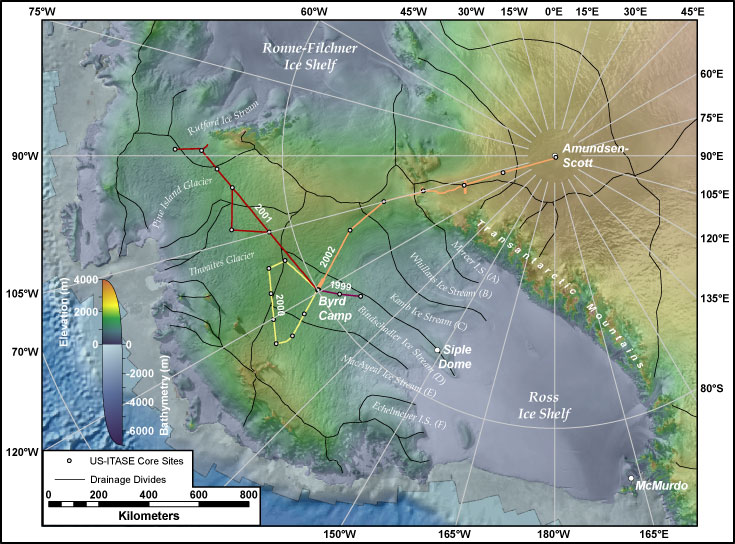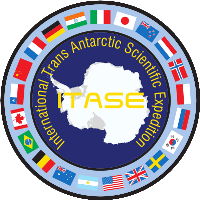- What is US-ITASE?
- St. Olaf Radar Program and ITASE Results
- Photos and Maps
- Contacts and Links
The US-ITASE program is a platform for multiple scientific research projects that focus on spatial variations across the West Antarctic Ice Sheet. The primary goal of the 4-year expedition is to determine the spatial variability of the last 200 years across the ice sheet. In cooperation with other international expeditions US-ITASE aims to contribute to how we understand ocean-ice sheet climate interactions, climate variabililty, and human impact on climate over the last 200 years. The US-ITASE heavy-traverse platform offers capabilities similar to a large ocean-going research vessel with logistic and scientific support for numerous researchers while traveling long distances (1000+ km) with limited limited intermediate support.
(From the US-ITASE Executive Summary submitted to NSF):
In its entirety, ITASE incorporates a wide range of general scientific objectives. Those which are specific to US ITASE address the following questions:
- What is the current rate of change in mass balance over West Antarctica?
- What is the influence of major atmospheric circulation systems (e.g., ENSO) and oceanic circulation on the moisture flux over West Antarctica?
- How does climate (eg., temperature, accumulation rate, atmospheric circulation) vary over West Antarctica on seasonal, interannual, decadal and centennial scales, and what are the controls on this variability?
- What is the frequency, magnitude and effect (local to global) of any extreme climate events recorded in West Antarctica?
- What is the impact of anthropogenic activity (e.g., ozone depletion, pollutants) on the climate and atmospheric chemistry of West Antarctica?
- How much has biogeochemical cycling of S, N and C, as recorded in West Antarctica, varied over the last 200+ years?
US ITASE provides an important spatial perspective for the shared research goals of a variety of research programs funded by the NSF, NASA and NOAA. Notably, questions 1-4 parallel closely themes identified by NSF's WAIS (West Antarctic Ice Sheet) intiative. It is expected that these overlaps of scientific purposes will make possible an efficient utilization of logistic resources in the execution of these linked research programs.
Complete
US-ITASE Science & Implementation Plan (from the University of Maine)
Maps of US-ITASE routes
Background
The St. Olaf College contribution to the US-ITASE program is a deep-penetrating radio echo-sounding system that can measure the bedrock surface beneath the ice as well as internal layers that have unique electrical properties. Total ice thickness data is useful to researchers who develop ice-flow models of the ice sheet. The immense size of the ice sheet makes it difficult to obtain high-accuracy thickness measurements over the entire continent. The long distance traverses of the US-ITASE program make it an ideal platform for ground-based radar measurements.
Internal ice reflections are usually related to deposition of volcanic debris (acids or ash) or dust layers. These layers give researchers a window into the accumulation and flow history of the ice sheet. Changes in the layer thickness along the traverse routes may be attributed to changes in snow accumulation due to climate or geographic changes (crossing a drainage divide, for example). Changes in the ice flow velocity due to bumps in the bedrock or changes in the bedrock character cause the ice to thicken or thin as the ice decelerates or accelerates.
Results, Publications & Data
Ice thickness values for the 2001 and 2002 traverses are published at the National Snow and Ice Data Center. The data can be found at the site by using search terms such as "Jacobel", "Welch", and/or "US-ITASE" or by using the following link: http://nsidc.org/data/docs/agdc/nsidc0264_jacobel/index.html
Numerous publications and presentations resulted from the radar work conducted during the US-ITASE program. The following is a list of published manuscripts and abstracts. Additional presentations were made at WAIS Initiative and Midwest Glaciology meetings without published abstracts.
Welch, B.C. and R.W. Jacobel, Bedrock topography and wind erosion sites in East Antarctica, observations from the 2002 US-ITASE traverse. Annals of Glaciology, (in press).
Jacobel, R.W. and B.C. Welch, A time marker at 17.5 kybp detected throughout West Antarctica. Annals of Glaciology, (in press).
Jacobel, R. W., B. C. Welch, E. J. Steig, and D. P. Schneider, 2005, Glaciological and climatic significance of Hercules Dome, Antarctica: An optimal site for deep ice core drilling, J. Geophys. Res., 110, F01015, doi:10.1029/2004JF000188 (PDF).
Siegert, M.J., Welch, B., Morse, D., Vieli, A., Blankenship, D.D., Joughin, I., King E.C., Leysinger Vieli, G.J.M.C., Payne, A.J., Jacobel, R., 2004, Ice flow direction change in interior West Antarctica, Science, 305, 1948-1951 .
Welch, B.C., S.A. Arcone, R.W. Jacobel, M. Helgen, 2004, Shallow (400-MHz) and deep (3-MHz) radar used to image wind erosion features in East Antarctica, Eos Trans. AGU, 85(47), Fall Meet. Suppl., Abstract C43A-0222.
Welch, B.C., and R.W. Jacobel, 2003, Analysis of Deep-Penetrating Radar Surveys of West Antarctica, US-ITASE 2001, Geophys. Res. Lett., 30(8), 1444, 10.1029/2003GL017210 (PDF).
Welch, B.C., R.W. Jacobel, K. Christianson, K. Coffel-Dwyer, 2003, Interactions Between Large Bedrock Features and Ice Sheet Dynamics Interpreted From Deep-Penetrating Radar Along the US-ITASE Traverse Routes, Eos Trans. AGU, 84(46), Fall Meet. Suppl., Abstract C21D-02 Invited.
Jacobel, R.W., B.C. Welch, M.T. Bills, T.J. Engle, 2003, Ground-Based Deep-Penetrating Radar Studies Along The US-ITASE Traverse, Eos Trans. AGU, 84(46), Fall Meet. Suppl., Abstract C21A-08 Invited.
Jacobel, R.W., B.C. Welch, M.P. Helgen, L.S. Smith, 2003, Hercules Dome - An Overview From the US-ITASE Deep Radar, Eos Trans. AGU, 84(46), Fall Meet. Suppl., Abstract C11C-0825.
Welch, B.C., R.W. Jacobel, S.F. Harris, L.S. Smith, 2002, Analysis of 2001 US-ITASE traverse deep-penetrating radar studies in West Antarctica, Eos Trans. AGU, 83(47), Fall Meet. Suppl., Abstract C15A-0924.
Welch, B.C., R.W. Jacobel, P. Pearson, 2002, Ice thickness and internal ice stratigraphy along the 2001 US-ITASE traverse route measured by ground-based radio echo-sounding, Eos Trans. AGU, 83(19), Spring Meet. Suppl., Abstract A41A-02.
Welch, B.C. and R.W. Jacobel, 2001, Radar studies of bedrock and internal stratigraphy along ITASE traverse routes, Eos Trans. AGU, 82(20), Spring Meet. Suppl., Abstract OS52A-03.
Instrumentation & Methods
We operate a 3 MHz radio echo-sounding system to transmit and receive radio waves through as much as 3 km of ice. This signal frequency translates to a wavelength of about 56 m in ice. The transmitter (made by the University of Washington) emits pulses at frequency of 250 Hz. The pulses are emitted by our transmitter antenna, a 40 m dipole dragged along the snow surface. 135 m in front of the transmitter is an identical dipole antenna that receives the signal. The signal is amplified and passed on to an oscilloscope board mounted directly on a field-hardened PC computer. The scope board identifies the incoming signal, digitizes it, and sends it to the computer to be stored on the hard drive. The scope board is extremely fast, sampling the signal at up to 100 million samples/second. Each sample of the signal is digitized to a 14-bit number meaning that the board is capable of processing up to 1.6 Gigabytes of signal data every second!
Fortunately we don't record data at such a fast rate, but use the board's speed to stack the incoming signal to remove much of the environmental radio noise that hides our reflected signal. We stack the data by averaging a few thousand of the transmitter pulses and their resultant echoes from the bedrock and internal layers. The traverse train travels at about 12 km/hr so we generally stack 1200-1500 traces every 10-12 meters. Stacking and the fast scope board allow us record a dense profile of traces while eliminating much of the noise that would make the data difficult to process and interpret.
Field Logistics
Our radar system operates primarily during the traverses between ice coring sites. The system and operator are towed as the very last sleds in the traverse train to eliminate radio noise from other instrumentation or reflections from the metal sleds and equipment. The receiver and operator are housed in a small shelter built on a wooden Komatik sled. The shelter protects the computer and operator from wind, cold, and snow. Power for the receiver is provided by a small gas-powered generator mounted on the back of the sled. The generator also provides power for battery chargers necessary to keep the battery-powered transmitter running. The shelter is also equipped with a GPS receiver to locate the data points. A survival bag is strapped to the front of the shelter in case of emergency.
The transmitter is towed 100 m or more behind the receiver sled. The transmitter and its battery sit in a small sled and are protected from the elements by the sled's nylon cover. The antennas for the transmitter and receiver are housed in strong hydraulic hoses and tied to the tow ropes to keep the antennas as straight and parallel as possible.
Picture of the receiver sled & transmitter sled
Picture of the interior of the receiver shelter
The photos and maps in this collection show how and where we do our research in Antarctica as part of the US-ITASE program. US-ITASE research is conducted during the austral (southern hemisphere) summer from late October through early January. In Antarctica this means 24 hours of sunlight, but the temperatures can still drop to -50°F near Byrd Surface Camp and -80°F at Amundsen-Scott Base at the South Pole. McMurdo Station on the coast is generally warmer but can get intense storms. An unusual warm spell in January 2002 saw record temperatures near McMurdo rise to 52°F.
The Slideshows Below show different photos from Itase
All photos by Brian Welch.
ITASE Traverse Map

Byrd Surface Camp


US-ITASE Traverse 2000



















US-ITASE Traverse 2001

























US-ITASE Traverse 2002






















McMurdo Station











St. Olaf Radar System






Direct questions
about CEGSIC & St. Olaf low-frequency radar program to: |
Direct questions about
this website or US-ITASE radar data to: |
|||
| Dr.
Robert W. Jacobel, CEGSIC Director & US-ITASE Principal Investigator
Office: (507) 786-3124 |
Brian C. Welch, Postdoctoral Researcher (2000-2008) hclewb@gmail.com |
|||
| |
||||
| CEGSIC Mailing
Address:
Center
for Geophysical Studies of Ice & Climate |
St. Olaf College undergraduate
researchers:
Matt
Bills - radar acquisition software: 2002-03 |
|||


